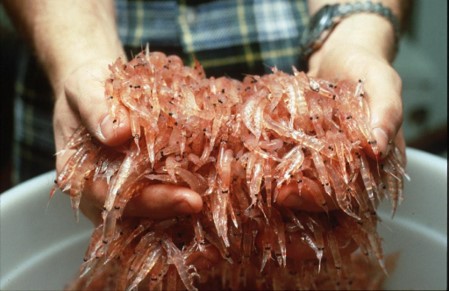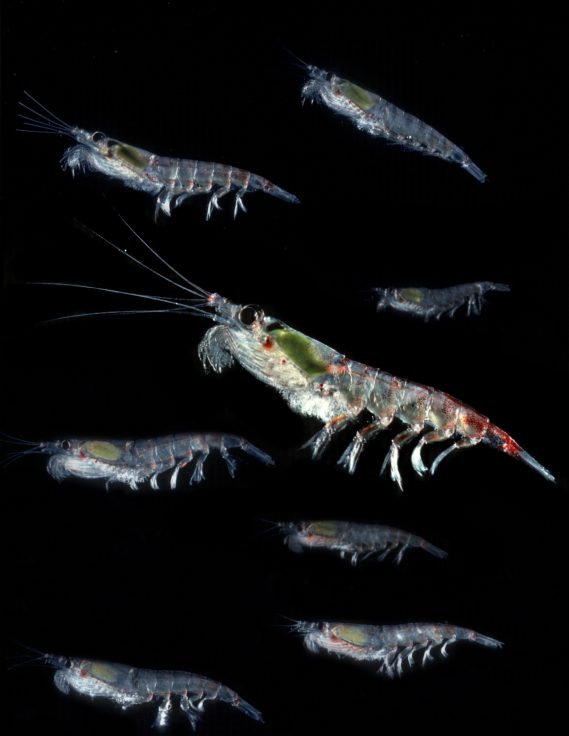Research priorities for effective krill management
An international ‘Krill Action Group’, including experts from the British Antarctic Survey, has identified several research priorities to advance the understanding of Antarctic krill (Euphausia superba) and improve the management of the krill fishery in the Southern Ocean.
The group, established in 2018 by the Scientific Committee of Antarctic Research (SCAR), with Support from Commission for the Conservation of Antarctic Marine Living Resources (CCAMLR), say that successful ecosystem-based management of Antarctic krill must address uncertainties in their recruitment, behaviour and ecological adaptation. The paper is published today (15 October) in the journal Communications, Earth and Environment.
Antarctic krill are well-known for their central role in the Southern Ocean food web, where they’re a food for marine predators such as seals, penguins and whales. They are also caught by an important fishery.

Lead author of the group’s first paper, Dr Bettina Meyer of the Alfred Wegener Institute in Germany, said that understanding of krill distribution and its dynamics has dramatically increased in the last few decades.
“However, there are still major gaps in our current knowledge, including controversy on population trends, overwintering, migration and other key aspects of krill biology,” she said.
Dr So Kawaguchi, a krill biologist at the Australian Antarctic Division and vice-chair of the action group, said that to ensure sustainable fishing, a better understanding of hotspots for krill spawning and larvae production is needed.
“Because krill abundance is highly variable, and the krill fishery is more concentrated than ever before, the risk of direct fishery impacts on the krill stock itself may be higher than previously thought,” he said.
Dr Meyer said that new opportunities for knowledge are arising from technological innovation and the potential to involve the fishing industry in research.
“A combined effort by the krill research community and fishery would enable a holistic approach to data and information collection and integration,” she said.

Co-author Dr Sally Thorpe, ecological modeller at British Antarctic Survey, said:
“Despite the global importance of Antarctic krill, there are still significant knowledge gaps in our understanding of its biology and ecology. Cooperation between scientists and the fishing industry to fill these gaps is particularly important given the environmental change taking place in the Southern Ocean and its potential impacts on krill distribution.”
Some of the key research priorities identified by the SCAR Krill Action Group (SKAG) are:
What controls the numbers and source of juvenile krill?
Surveyed numbers of juvenile krill are far below those required to explain the patterns in abundance of adults. Further research on environmental conditions and krill behaviours that favour recruitment of juveniles to the adult population are needed. This would include plankton surveys from fishing vessels, echo sounders on seals, and remote sensing of sea ice from satellites.
Resolve the debate over whether krill populations have declined
Understanding whether krill populations have been impacted by the known ecosystem changes over the last century is necessary to inform future projections. Krill fishery management does not explicitly factor in the effects of long-term warming of the Southwest Atlantic sector of the Southern Ocean (habitat of 70 percent of the known krill population), and projected adverse consequences for krill.
Pinpoint the hotspots of successful spawning which merit protection
Data focused on resolving where and when spawning hotspots occur can be used to assess the fishery risk to the krill stock. Studies show that successful spawning occurs primarily near shelf/slope areas during summer. Given that the fishery is now concentrated on the shelf during autumn and winter, it may mean that fishing pressure on the spawning portion of the population is higher than previously thought.
Identify seasonal overlaps between the fishery and successful spawning stock
Catch limits may not be as precautionary as intended. Adult krill distribution shifts from mainly off-shelf in summer to on-shelf in winter, where the present-day fishery effort is focused. Understanding the mechanism of this behaviour and what portions of the population are involved, are critical to understanding the impact of the on-shelf fishing on this winter krill population.
Future-proof fishery management for climate change
A better understanding of how krill populations respond to changing temperature, food availability and environmental conditions, needs to be built into decisions about fishery management.
The SCAR Krill Action Group involves scientists from the UK, US, Germany, Australia, China, and Argentina.
Successful ecosystem-based management of Antarctic krill should address uncertainties in krill recruitment, behaviour and ecological adaptation by Meyer et al is published in the journal Communications Earth & Environment. Read here.